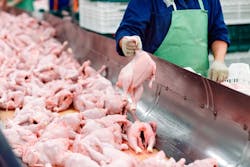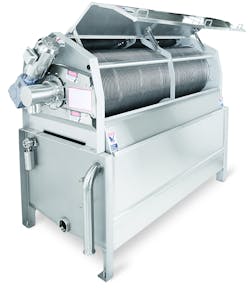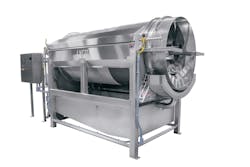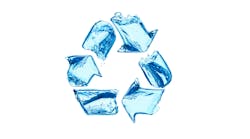For meat and poultry processors, water consumption, water reclamation and wastewater treatment are key functions of plant operations. Meat processing — and poultry processing in particular — are activities that involve high water usage. For every gallon purchased, the processing plant pays to eliminate fats and proteins from that water. An average size plant can easily end up with 1,000,000 to 2,000,000 gallons of water daily that is laden with proteins and fats from meat, fat, blood, skin and feathers, and mixed with grit and other inorganic matter. Meat and poultry processors are required to remove the majority of this soluble and particulate material in their wastewater prior to discharge from the plant to achieve compliance with local, state and federal environmental regulations. Treatment of such high-strength organic-content wastewater can present significant challenges to comply with these mandates.
Water reuse
Many meat and poultry facilities have recognized the need to recycle process water. The use of recycled process water has grown substantially to offset the increased cost of water, minimize wastewater treatment costs, reduce costly municipal wastewater discharge fees and support corporate sustainability initiatives. Water used for processing may be reused for the same purpose provided measures are taken to reduce physical, chemical and microbiological contamination. The technology, chemistry and processes exist today to feasibly and economically integrate water reuse into any meat and poultry processing operation.
Upstream liquid/solids separation screens reduce BOD, TSS and TKN
Traditionally, meat and poultry processors have approached wastewater treatment (WWT) first physically and then chemically and finally biologically. Processing plants use dissolved air flotation (DAF) as a physical-chemical separation method, with subsequent aerobic or anaerobic biological treatment prior to discharge.
But increasingly, upstream from DAF, meat and poultry processors are embracing the use of technologically advanced liquid/solids separation screens to reduce biochemical oxygen demand (BOD) loads, total suspended solids (TSS) and total Kjeldahl nitrogen (TKN) levels. Municipalities have long used BOD loads to determine surcharges for meat and poultry processing wastewater discharges.
With the recently established lower limits set on TKN levels by the Environmental Protection Agency (EPA), many meat and poultry processors have had to make system changes to their WWT to meet these new allowable mandates — or face additional surcharges for excessive total nitrogen.
Protein, in particulate form, is a major driver of TKN levels. Significant reductions in BOD must be achieved to arrive at the desired level of TKN. To guarantee reaching discharge TKN concentration to comply with EPA requirements, virtually all BOD needs to be removed prior to nitrification. This has put a necessary emphasis on upstream screening to remove a higher volume of protein-laden effluent prior to reaching WWT.
Additionally, cost savings by screening upstream are considerable. The reduction of fat and protein content from these high-strength wastewaters upstream reduces the amount of chemical and biological processing needed to be done downstream in WWT. Energy consumption, treatment chemicals and manpower demand considerably higher costs in WWT compared to upstream screening.
Further, much of the secondary protein nutrients from DAF screenings and sludge from biological treatment, if obtained through upstream screening, would not only increase a plant’s byproducts revenue stream significantly but would also reduce the plant’s sludge handling costs.
Inefficiencies in upstream liquid/solids separation screens
Most meat and poultry processors in the United States are using some form of liquid/solids separation screening to reduce wastewater solubles and particulates. This would include internally fed rotary screens, externally fed rotary screens and shaker-and-bar type screens. Traditionally, these are single-screen applications, using primary screens to remove large solids, as well as feathers and viscera in poultry processing. A secondary single-screen, typically 20,000 thousandths of an inch (500 microns), is then used to further remove fine particulate.
Because liquid/solids separation equipment is subjected to long periods of operation under stringent and harsh conditions, many system designs do not satisfactorily maintain consistent effluent flow, particulate capture and uptime. In many meat and poultry processing facilities, the efficient operation of these screens is diminished by blinding — when fats and other slick particulates clog the screen openings. Most mechanical screens let material pass through because they do not have the ability to manage the volume of particulate matter in the slurry. This is a common problem with traditional screening equipment — limiting the volume of wastewater and load that can be moved through a screen, which causes water and particulate to make their way through, unfiltered.
For a liquid/solids separation system to be effective while maintaining high-uptime operability, it must be engineered to be heavy-duty and durable, user-friendly, tool- and mechanic-friendly, operate with minimal maintenance, and have an effective clean-in-place (CIP) system.
Sanitary zero-maintenance screen
Supporting the integration of these critical factors into machine design, a new liquid/solids separation screen was developed that not only effectively screens out solids to a very close tolerance while setting the highest standard for sanitary operation in a rotary-drum screen but also requires virtually no maintenance. The Sanitary Zero-Maintenance Screen was developed by Lyco Manufacturing, a manufacturer of commercial cooking and cooling equipment and liquid-solid separation screens for the food and beverage industry.
The Zero-Maintenance Screen consists of three sequential automated processes, as well as a fully automated, CIP capability:
Rotary-drum screening to 0.020 inches
This unique screen utilizes rotary action to separate solids from the water. Protein- and fat-laden effluent enters the drum, and as it rotates, the suspended particles larger than 20 thousandths of an inch (0.020 inches) are screened out and discharged.
Automated fat/scum skimming
The screened water then enters a skimming tank where it is automatically skimmed of fat and scum. A programmable logic controller (PLC) monitors agitation and controls a weir inside the tank to precisely skim off the accumulated fat layer.
Secondary self-purging dual-canister filtration
From the skimming tank, the prescreened water is pumped through a fully automated dual-canister water filtration system at a rate of between 50 and 400 gpm. The system removes the remaining fine suspended solids.
The PLC-controlled canister filtration system is designed with a self-purging mechanism that discharges particle buildup on the filters, without interrupting the flow of water. The pressure of the water entering and leaving the canister is monitored by the PLC. When the screen begins to fill up and the pressure reaches a critical differential, the screen is flushed, causing the protein and fat particles to be discharged from the canister, permitting the water to continue flowing through the filter.
In the event that the concentration of proteins and fats in the water is sufficient to cause filter blinding following several self-purges, the PLC will automatically divert the water to the second canister, without loss of throughput, to continue the filtration process. The filter(s) in the initial canister are then easily and quickly manually accessed and purged, and are once again ready to accept water for filtering. Mean time between manual purges ranges between four hours and several days, depending on the concentration of proteins and fats in the effluent.
Exiting the canister filtration system, the screened and filtered water is now clean enough to be recycled for process use a second time.
Sanitary clean-in-place system
The Sanitary Zero-Maintenance screen provides CIP capability. It is equipped with spray balls running the length of the tank cover and at the standoffs for cleaning during CIP operation.
The system was designed to have complete access, as well as side-opening doors to easily access the tank inside for cleaning.
Supporting these unique functionalities of the Sanitary Zero-Maintenance screen is its mechanical simplicity. The screen was designed to eliminate trunnion wheels and bearings. It rotates on oil-impregnated bushings, removing the need for routine bearing lubrication.
Micro-drum screen: Optimized liquid/solids separation for water reuse
The recently released Micro-Drum Screen has taken liquid/solids separation for meat and poultry operations into a new level of process capability. With its advanced liquid/solid separator system, it reduces soluble protein and fat particulate using screens with mesh sizes 0.005 inches to 0.008 inches — effectively 2.5 times finer than secondary screening systems. This enables process water to be reused.
In poultry processing, for example, plants that are using fresh water to keep offal and feather screens clean, can now take the 0.020-inch screened water from its secondary screens, run it through the Micro-Drum Screen with its 0.006-inch spacings, and reuse this water in place of fresh water. Assuming feather and meat screens each have 25+ nozzles, these plants will save 120 gpm of fresh water operating at peak performance.
This water can also be used for truck wash-down hoses and non-sanitary wash-down areas, replacing the need for using fresh water.
Developed by Lyco Manufacturing, the Micro-Drum Screen utilizes rotary action to separate protein and fat solids from the water. The screen’s design combines the benefits of wedge-wire and wire mesh stainless steel construction to achieve improved performance.
In addition, this equips the operator to recover extra proteins and fats during initial processing stages prior to WWT. The Micro Drum Screen considerably reduces BOD, TSS and TKN. Production-run tests in a poultry processing facility show results of 24.4% reduction in BOD, 29.5% reduction in TSS and 14.8% reduction in TKN.
Meat and poultry processors can realize up to 30% savings on sludge removal and handling. Depending on the processing speed and type of mesh used in the screen, recovered material amounts can range from 600 to 1,500 pounds per hour.
Operators can preprogram a cleaning cycle that lasts 5 to 15 minutes as needed, recycling the drum's own water through the CIP system, so no fresh water is required for cleaning the drum. As a backup, the screen has a unique mechanical traveling spray CIP system. Using only two spray nozzles moving back and forth, the system effectively keeps the screen from clogging, but consumes only 10 gpm.
Mechanical integrity of rotary-drum screens
A key aspect relating to the mechanical integrity of these liquid/solids separation rotary drum screens is the centrifugal-casting of their drum support rings. It is common knowledge that rotating drum screens will eventually break apart. This is an inherent weakness in the way virtually all drum screens are designed and manufactured — which is to say, the stainless steel plate is rolled and welded. It is nearly impossible to get a drum screen of this size within close enough cylindrical tolerance, after having been rolled and welded, to keep it from eventually breaking apart. Consequently, almost all rotary-drum screens that have been conventionally manufactured have a limited life.
That is not the case, however, with the Sanitary Zero-Maintenance Screen and the Micro-Drum Screen. These drum screens are manufactured without rolled plate, and there is no welding. The drum supporting rings are centrifugally cast to within 15,000ths-of-an-inch roundness. Molten metal is poured into a cast that is spinning at high speed. Consequently, they maintain their roundness for the life of the drum without breakage.
Supporting sustainability
Water reuse is critical to supporting a sustainable future. Considering the high volumes of water needed to process meat and poultry, water recycling becomes a key issue for these facilities. But each meat and poultry processing application is unique and requires careful analysis to arrive at a liquid/solids separation solution that will achieve the desired water recycling goals for that plant.
Treating wastewater with advanced screening technologies and using the reclaimed or recycled water for a renewed and beneficial purpose helps meat and poultry processors source alternative water supplies, improve plant efficiency, reduce process costs and contribute to improved profitability.
Jim McMahon writes on industrial, manufacturing and technology issues. His articles have appeared in business and trade publications worldwide. Lyco Manufacturing is a leading manufacturer of commercial cooking and cooling machines, liquid-solid separation screens, root crop peelers/scrubbers and snap bean equipment for the processing of pasta, rice, dry beans and vegetables. The company has designed and installed thousands of machines for 50 of the top 100 food companies in North America and many smaller food processors.





